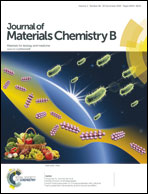Interleukin-10 chimeric protein to protect transplanted neural progenitor cells from immune responses
Abstract
The provision of adhesive scaffolding and protection from inflammatory responses are important for enhancing graft survival. We previously developed a functional hydrogel that significantly enhances the survival of cells transplanted into the midbrain striatum. Although graft survival reached approximately 40% using this hydrogel, the survival of transplanted cells required further enhancements because it ultimately produced a decrease in the number of transplanted cells. Therefore, we developed a hydrogel system that can locally prevent the inflammatory response. This hydrogel was modified by the addition of the interleukin 10 chimeric protein (IL10CP), which is selectively released from the hydrogel when triggered by an inflammatory response. This design protects transplanted cells from inflammatory response, while other host cells remain unaffected. The IL10 domains are selectively released from the hydrogel, which act locally on the immune cells to prevent the inflammatory response without the administration of an immune suppressor. The selective release of IL10 domains from the hydrogel and their activity to prevent immune responses were evaluated using various approaches. Moreover, the ability of the IL10CP-modified hydrogel to protect cells was investigated using an in vitro co-culture with activated microglia. The IL10 incorporated into the hydrogel was selectively released by the activity of matrix-metalloproteinase 9 (MMP9), and the neural progenitor cells encapsulated in the IL10CP-immobilized hydrogel were protected from activated microglia by the release of IL10s from the hydrogel by the MMP9, produced by the activated microglia. These results show that the IL10CP-modified hydrogel will be useful as a biomaterial for improving the survival of transplanted cells.


 Please wait while we load your content...
Please wait while we load your content...